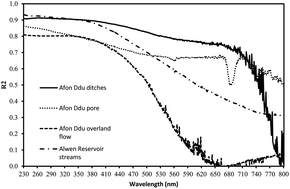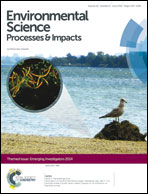UV-visible absorbance spectroscopy as a proxy for peatland dissolved organic carbon (DOC) quantity and quality: considerations on wavelength and absorbance degradation†
Abstract
Absorbance in the UV or visible spectrum (UV-vis) is commonly used as a proxy for DOC concentrations in waters draining upland catchments. To determine the appropriateness of different UV-vis measurements we used surface and pore water samples from two Welsh peatlands in four different experiments: (i) an assessment of single wavelength proxies (1 nm increments between 230–800 nm) for DOC concentration demonstrated that 254 nm was more accurate than 400 nm. The highest R2 values between absorbance and DOC concentration were generated using 263 nm for one sample set (R2 = 0.91), and 230 nm for the other three sample sets (respective R2 values of 0.86, 0.81, and 0.93). (ii) A comparison of different DOC concentration proxies, including single wavelength proxies, a two wavelength model, a proxy using phenolic concentration, and a proxy using the area under a UV spectrum at 250–350 nm. It was found that both a single wavelength proxy (≤263 nm) and a two wavelength model performed well for both pore water and surface water. (iii) An evaluation of the E2 : E3, E2 : E4, E4 : E6 ratios, and SUVA (absorbance at 254 nm normalised to DOC concentration) as indicators of DOC quality showed that the E4 : E6 ratio was subject to extensive variation over time, and was highly correlated between surface water and pore water, suggesting that it is a useful metric to determine temporal changes in DOC quality. (iv) A repeated weekly analysis over twelve weeks showed no consistent change in UV-vis absorbance, and therefore an inferred lack of degradation of total DOC in samples that were filtered and stored in the dark at 4 °C.


 Please wait while we load your content...
Please wait while we load your content...